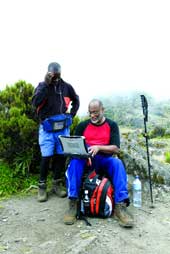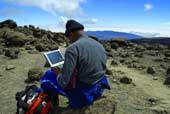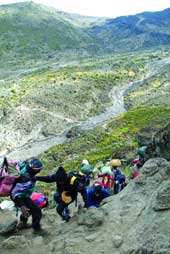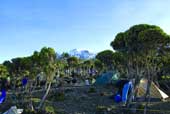Mount Kilimanjaro, Africa's highest mountain and the tallest free-standing mountain in the world, stands 5,895 meters, or 19,341 feet, at its peak. Located in northern Tanzania along the border with Kenya, Kilimanjaro ' or Kili, as some call it ' is actually three volcanoes. The two main peaks ' Kibo and Mawenzi ' form the summits.It's also a mountain known for its diverse and sometimes punishing climates, which can be challenging enough for climbers, but perhaps even more so for technical gear such as a laptop PC.Through a fortunate turn of events, I had the opportunity to put myself to the ultimate test, spending six days in early July trekking up and then descending Kili's varied terrain. And as a technology writer, it also gave me the opportunity to put a rugged laptop to the ultimate test too.The primary risk to people climbing the mountain is altitude sickness. Park authorities estimate that almost one in four people who climb Kilimanjaro never reach the crater at the top. And they say there are a couple of deaths per year on Kilimanjaro, though independent observers say this figure could be as high as 10 per annum, according to the book 'Kilimanjaro,' a popular trekking guide by Henry Stedman. But it's also a bad place for laptops, perhaps one of the worst in the world, with mist, dust, desert heat and bitter cold.This is why it is so important that trekkers adopt the concept of pole, pole, Swahili for slowly, slowly. You hear it from the guides who take you up the mountain and the porters who carry your heavy bags and camping equipment. Pole, pole, if you want your body to acclimatize to the altitude. Pole, pole, if you want to make it to the top.[IMGCAP(1)]And especially, pole, pole if you're lugging an extra 6 pounds in your backpack. After learning that I was willing to take a rugged laptop on the trek, the folks in GCN's Test Lab searched for a vendor that would provide a computer for the climb. Panasonic came through. So I took a Panasonic Toughbook CF-19 with me to see how it would work in the different environments of the mountain.The CF-19 would be subject to four distinctly different environments as we climbed, any one of which could spell doom for a normal laptop. My goal was to carry the laptop with me, exposing it to the elements, and power it up from time to time, taking notes about the journey and the amazing scenery found nowhere else in the world. If it even survived until the third day, I would be impressed.The Toughbook sported a 1.06 GHz Intel Core Duo U2400 processor (Centrino), 10.4-inch Touch Screen XGA display, 80G shock-mounted removable hard drive, 1G of RAM, Intel 802.11a, b, g wide-area wireless and Global Positioning System capability, Windows XP SP2 software, Trusted Platform Module 1.2, and Bluetooth. There was no optical drive to bog me down.The folks at Panasonic had engineered the laptop to work with the added GPS. However, when I received the notebook, it didn't have GPS software installed for Tanzania. I got the Toughbook the day before I was to leave for the trip, so I didn't have time to buy the software.It would have been nice to have the GPS software to take screenshots that mapped out the various locations on the mountain to go along with the story.It would also have been nice to have some type of satellite wireless connection to keep a blog along the way. But that wasn't possible.I was initially impressed with how sturdy and compact the laptop was in its magnesium metal alloy casing. The rubber tabs protecting the ports seemed like an excellent way to keep dust and dirt from getting into the computer on the trail.Although I wouldn't need to plug anything into the ports during the trek, covering them was a good idea.And I liked the fact that the computer could turn into a tablet. I thought this could come in handy should I want to take notes along the trail.The journey began at the Machame Gate, which sits at 1,828 meters (5,977 feet). I checked the laptop after signing in with the park rangers. The CF-19 battery indicated that I had six hours and 11 minutes of time remaining, 96 percent of capacity. I thought the real test for the Toughbook on this trek might be the battery. Will it hold up for six days? Also, how will it work in the frigid regions at the top, assuming I make it that far?[IMGCAP(2)]Our group consisted of eight people: my wife, Khadija, and I; my wife's sister Batul and her husband, Mahsen; Batul's co-worker Kimani; my sister Sonya and her husband, Mike; and Harminder, an industrial-arts teacher from Vancouver, Canada.As the porters packed up the equipment and our bags, our group of eight trekkers mingled in the car park. We were given our box lunches for the trek, and we met our guides. Bali, the head guide, was a Chagga, the tribe that has lived around the slopes of the mountain for centuries. The two assistant guides were Tade and Prosper.The first day consisted of a seven-mile hike through the cloud forest. Everyone seemed in good spirits as we started the first leg of our journey. As we embarked on the trail around 12:30 p.m., the sun came out, taking the slight chill out of the air. We tackled a wide, dirt trail ' big enough for a 4-wheel-drive Jeep or truck ' that wound its way through the forest. Sun rays cut through trees covered with green moss.Before starting up the mountain, my wife asked twice if I was going to let the porters carry the laptop. No, I told her, I needed the computer close to me to check it throughout the trip. After about three kilometers, the 4-wheel-drive trail ended, and the path got narrower and steeper. In some spots it was muddy. Bali said it's not rain, but mist from the clouds that creates the mud. That type of moisture can easily seep into most laptops, because you are basically walking through clouds. But the CF-19's rubber stoppers kept the moisture out.Further along the trail, we stopped and listened to the silence ' at times, the forest is incredibly quiet.More clouds rolled in, and we heard the mist settling on the trees. A stream flowed somewhere in the forest. I thought it was a good time to check the laptop ' I wanted to see how it would respond with all the moisture in the air. As I expected, it booted up right away. Bali took an interest in the computer and watched as I typed a few more notes about the journey. That was about 4:30. We still had another two hours to walk before arriving in camp, just after sunset.The rigors of the first day settled in. Hiking for six hours up a steep trail with a backpack full of daily essentials ' such as water, snacks, toiletries, a heavy raincoat ' along with a 6-pound laptop can take its toll on the body. From the Machame Gate to the camp, we ascended from 3,951 feet to 9,948 feet.The porters had set up our tents, and there was hot coffee and tea awaiting us. Each day as we came into camp, this would be the routine, and there would also be popcorn and biscuits along with the hot beverages. We signed in at the ranger station.Later that night, we gathered our tired bones around a tent for dinner, which consisted of soup, rice and beef. We couldn't all fit in, so we let the hikers who got into the camp late eat in the tent. The rest of us sat on stools outside.Morning arrived, and we were greeted with views of snow-capped Kibo ' so close it seemed, but yet so far ' another three days' journey. The porters had laid out a mat with our breakfast, and we all gathered around, sore but anticipating the day's journey through the moorland, the next environment that would challenge me and the CF-19. We began the trek at 8:30 as the sun again melted away the morning chill.[IMGCAP(3)]The landscape changed during the course of the day. We moved through twisted heather bushes that eventually gave way to a dusty trail that wove its way through rocks and boulders. The lush vegetation of the forest disappeared, replaced by a starker landscape. We started to see the lobelias, a cabbage-shaped tree that can grow two feet tall among shiny black obsidian rocks.Bali stood over me as I typed some notes about the trek. The trail has been dusty and the sun at times searing, but the laptop is still holding up. It's got some fingerprint smudges from my dusty hands, but all in all it seems to be running at peak efficiency. As I shut down, I hear Bali quizzically say, 'Windows' as he watches the screen disappear. Mine is likely the only laptop on the mountain today, and from the reaction of the guides, perhaps the only one they have ever seen up here.Later that night at Shira camp in the darkened tent, I turned on the laptop again. The screen lit up, but not the keyboard. My wife pointed this out; even on children's play laptops, the keyboard lights up. I agree with her point.I think that for military personnel or first responders, a keyboard that lights up in the dark would be necessary. I unlocked the release button and turned the monitor into a tablet. I discovered that if I brought up the keyboard for the tablet and used a stylus, I could work in the dark. It wasn't until after I got off the mountain that I found the stylus tucked away in a slot at the bottom of the screen. Hence the CF-19 was in for more dirty fingerprints.Before closing the computer, I checked the battery icon, which indicated eight hours remaining. I wondered how this could be ' it had six hours remaining the day before ' which led me to question whether I was getting proper readings about the battery life. Still, I thought, the major test will be the cold. Will it turn on and run at the top? Will I even make it to the top?I stepped outside the tent. The sky was full of stars, and I heard the murmur of voices in other tents across the Shira Plateau.The third day of the trek, we moved into the alpine desert. We climbed to 4,530 meters (14,858 ft.) and then descended to 3,985 meters (13,074 ft.) to the Barranco Camp. This is important for acclimatization to the altitude, we were told. At times, as in the moorlands, the landscape ' strewn with dark boulders ' looks like another planet.[IMGCAP(4)]When we broke for lunch, I immediately checked the Toughbook. This time, I wanted to do more than just open Word to write notes. I checked the notebook's multimedia capabilities, clicking on sample music and playing the sample tracks ' a jazz clip and some classical music.The computer was still holding up. I clicked the battery icon and saw that I had five hours and 33 minutes left, which is 84 percent capacity.I thought about the discrepancy with the times of eight hours remaining last night when I switched from tablet mode back to laptop. I could only surmise that the processor estimates the battery life for various programs. Listening to music or viewing multimedia programs draws on more resources, such as speakers and video, so the processor gives an estimate based on which program is running. I still felt confident that I had enough battery power to use the computer ' should I make it ' at the top.After lunch, we reached the highest point of the day and then descended a hill, crossing a few small streams. The laptop might have gotten a little water splashed on it, but it seemed unaffected. Barranco was the last camp site where all eight members of our group ate dinner together.The trek to the last campsite before attempting the summit started out with a difficult climb up the Barranco Wall. It was narrow and rocky, and we had to use both hands to scramble over rocky ledges. This was the longest day for us. It was eight hours of walking over terrain that accommodated only the sturdiest of vegetation, up hills and then down into valleys where we crossed small streams.[IMGCAP(5)]We headed to the Karanga Valley, the last place where porters can get water from the mountain streams on the Machame route. Some groups stop to camp at Karanga to build in more time to rest and acclimate before the last ascent to the top instead of proceeding to Barafu Huts. In hindsight, I wish we had done this.The trek was long and grueling, to say the least. We traveled up and down rocky, dusty slopes. However, there were excellent views of Kibo along the way. I typed some quick impressions of the trail and Barafu when I got to camp. The weather had turned cold. Barafu means ice in Swahili, and the camp was probably given this name because it's close to Kibo's glaciers.When we stumbled into camp, we saw porters preparing to take equipment and bags back down the mountain. That's when we learned that my sister-in-law and her husband didn't make it to Barafu. They had to descend to another camp with their guide, Prosper. Later, we heard they went back to Karanga after my wife's brother-in-law, Mahsen, started coughing up blood.A solemn feeling pervaded our group as we digested the news. We were also told that at this point if anyone was feeling sick, we needed to alert our guides because beyond that point, there was no way for an ambulance to evacuate us. And also, there are no techies on the mountain to fix broken computers. We ate dinner and tried to rest because we had to rise around 11 p.m. to prepare for the final ascent.Our fifth day began at midnight. The remaining six of us assembled to start the climb up a rocky slope to join other trekkers headed to the summit. The scene reminded me of coal miners. Most people had headlamps to help them see up the trail. Mine didn't work so I borrowed a small handheld flashlight from my brother-in-law, Mike. As we started our trek, I looked up the mountain and saw a line of lights; I looked down the mountain and saw another line of lights.My backpack felt snug against my back. I took out some items, trying to make it as light as possible. I wondered if the laptop would freeze as I ascended the mountain.We climbed small cliffs to get out of the camp. I started to get tired and asked for more frequent rest stops, but my guide, Tade, warned me we could freeze if we stopped too often and too long. He led me and another trekker, Kimani, on a faster pace, and we broke away from our group.It started to get very cold, and suddenly, as we neared the snow caps, the wind kicked in with a whooshing sound. I felt it sway me from side to side a bit, and then I knew that I was in the mix.We no longer heard any response from our group below as we continued to ascend and the frigid winds howled around us. I tried not to think about the top or look too far ahead. Instead, I concentrated on putting one foot in front of the other, but my legs were like lead. I stumbled and fell over the rocky shale and gravel several times, giving the CF-19 a good jolt. Twice Tade massaged my chest to keep my blood circulating.The water in my canteen froze; a big block of ice stopped any water from flowing to my lips. Fortunately, Kimani's bottled water had not frozen completely, and I took a swig of his, which was very soothing. I trudged on and again stumbled forward. As I rolled onto my back, Tade asked, 'Is this it? Are you finished?' And like a fighter who has been knocked onto the canvas, I pulled myself up and trudged on.I prayed, dug deep within myself and kept pushing forward as the sun started to rise. It's only half an hour, Tade said. When I reached Kibo's crater rim, Stella Point, Tade said, 'You're at the summit.' I had made it to the crater rim, far enough to get a green certificate for my effort '18,871 feet.Trying to catch my breath, I pulled out the Toughbook. Temperatures at the top in the morning can get as low as 16 degrees Fahrenheit. The wind blew around me as the computer booted up, unaffected by the chill that had frozen the water in my canteen. It was 7:28 a.m. I had three hours, 56 minutes of battery time left. I took off my gloves to type in my impressions of being on the top of Mount Kilimanjaro, but it was far too cold for me to leave my fingers exposed for long. Switching the laptop into a tablet and using a stylus would have helped. The Toughbook fared better than I did on the top of the mountain.I'd lost my cameraman, my brother-in-law Mike, who had to turn back only two hours from the summit because my sister could not keep her eyes open. I was able to get one picture at the top, though, by other means.Coming down a mountain can be just as taxing as climbing. The descent from the mountain actually started the day before. Walking back to Barafu took a good 21'2 hours, and then we had to break camp to descend three hours to another camp. I walked like an old man, but I had a good feeling knowing that I'd survived the mountain. Plus, the laptop held up. The only wear and tear seemed to be the fingerprint smudges from the dust on the touch screen.[IMGCAP(6)]I was not able to test the Toughbook to see how it handled extreme vibrations on the mountain. But I did later on a bus ride from Dar es-Salaam, Tanzania, to Mombasa, Kenya. For about 35 miles near the Kenyan border, the highway turns into a bumpy dirt road.The bus rattled on, passing thatched huts with corrugated tin or straw roofs. Bags that weren't secure in the overhead racks almost fell to the floor.At times, it seemed as though the screws and bolts holding the bus together would come loose. My backpack with the Toughbook was on the floor under my seat taking the brunt of the vibration. If I'd had a regular laptop, I would have been concerned about damage to the hard drive. But I had no worries about the Toughbook; it booted up with no problems when I tested it.Even though she was impressed with the Toughbook, my wife still doesn't think it should be taken on a trek up Kilimanjaro. I found the 6-pound laptop weighed me down at times during the trek. However, I could see how the sturdy, compact design, long battery life and ability to withstand dampness, heat and bitter cold could make it well-suited for emergency responders and other field technicians who might need a rugged laptop.But if you do decide to tackle the snow-capped mountain and have a need to take along a rugged computer, remember: Pole, pole. And if you need to take a laptop PC, you'd do well with the CF-19. It will likely survive the trip better than you do.
AT THE SUMMIT: Author and computer make it to the top.
Photp by Kimani Mbugua
Day 1: Author checks Pansonic Toughbook before the start of the trek at the Machame Gate while fellow trekker, Kimani, looks on. Will the battery hold up? Will it work in the frigid regions?
Photo by Michael Bornheimer
DAY 2: During lunch break in the moorlands, author boots up the Toughbook while guide, Bali, looks on.
GCN Photos by Michael Bornheimer
DAY 3: The laptop is still holding up as author treks through the mountain's desert region.
GCN Photos by Michael Bornheimer
DAY 4: The day begins with an exhausting scramble up the Barranco Wall as trekkers head to Barafu Camp.
GCN Photos by Michael Bornheimer
DAY 6: With the Kibo Peak standing in the background, trekkers and porters prepare for the descent from Kili.
GCN Photos by Michael Bornheimer
DAY 1
Cloud forest
Machame Hut (3,032 meters, 9,948 feet)
DAY 2
Moorlands
SHIRA CAMP (3,847 meters, 12,621 feet)
DAY 3
Alpine desert
Barranco huts (3,985 meters, 13,074 feet)
DAY 4
Desert
Barafu huts (4,681 meters, 15,358 feet)
DAY 5
The final ascent
Stella Ppoint (5,752 meters, 18,871 feet)
Day 6
Descent
Mweka route
To read a complete account of Rutrell's adventures, go to GCN.com and enter GCN.com/839 into the search field.













